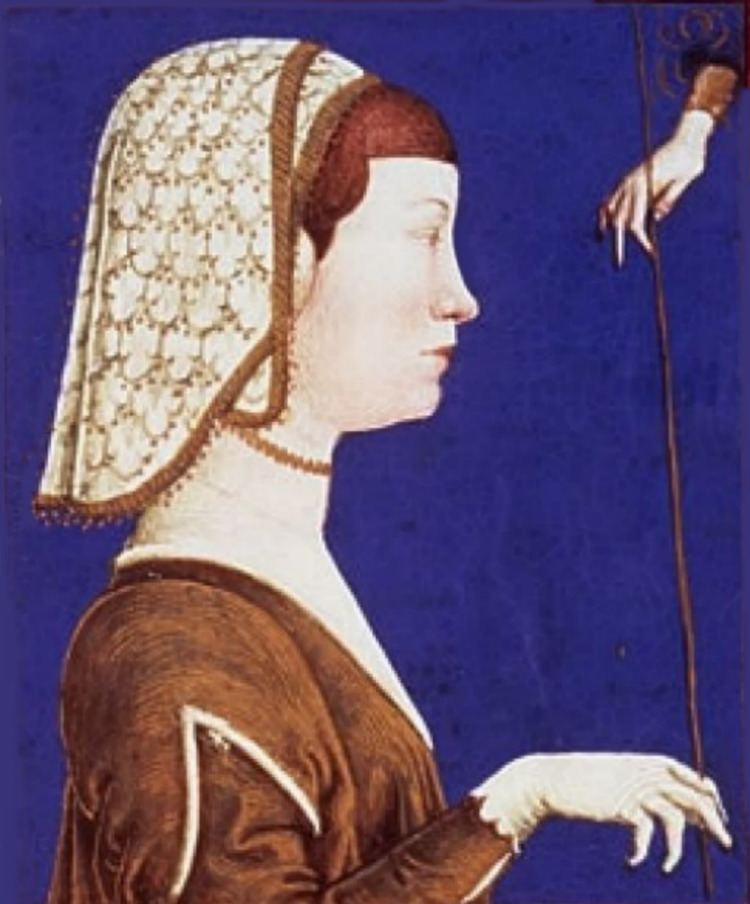Name Eleanor Naples, House House of Trastamara | ||
 | ||
Born 22 June 1450Naples ( 1450-06-22 ) Children Alfonso I d'Este, Duke of Ferrara, Isabella d'Este, Ippolito d'Este, Beatrice d'Este Parents Isabella of Clermont, Ferdinand I of Naples Similar People | ||
Eleanor of Naples (Leonora or Eleonora of Aragon): (1450 –1493) was duchess consort of Ferrara by marriage to Ercole I d'Este, Duke of Ferrara. She was the first duchess of Ferrara, and mother of many famous Renaissance figures. She was a well known political figure, and served as regent of Ferrara during the absence of her spouse.
Contents
Life
Born to King Ferdinand I of Naples and Isabella of Clermont. Born into wealth, she was the first daughter, and second child, born into her family of six brothers and sisters. Not much is known of her childhood or early life growing up as the first princess of Naples, but she was thought to be the first consort of Sforza Maria Sforza, duke of Bari.
Duchess of Ferrara
Eleanor would go on to marry Ercole d’Este (26 October 1431 – 15 June 1505) in July 1473, her supposed second husband. It is claimed that this marriage was met with much celebration. Ercole was said to be, “…an unscrupulous and devious ruler.” He came to be Duke of Ferrara in 1471, taking the title upon the death of his half-brother, Borso, and would rule until his death in 1503.
When she was passed through Rome in June 1473, on her way to marry Ercole d’Este, duke of Ferrara, she was received grandly (she would go on to marry him a month later). Two nephews of Rodrigo Borgia, who was a cardinals at the time, were there to greet her. They wanted to make a good and lasting impression on the Neapolitan Princess. She wrote to her father that she was given a lavish apartment, stating that even her chamber pot was made of gilded silver. In her correspondence with her father, she spoke of the banquet thrown for her, which lasted six hours, and it was an endless succession of food, accompanied by music, dancing and poetry. “The treasures of the Church, is being put to such uses,” she wrote in astonishment in her letter. This has been suspected to be a political power play by the Borgias, in attempt of gaining favor with royalty and gaining more political power.
Despite her husband’s ill temper, Eleanor was said to have been an active and dedicated spouse. She ruled in her husband’s stead when he was absent. He was absent in 1482-1484, when he fought a war with the Republic of Venice. Due to growing up in the Argon court of Naples, she brought with her lots of political knowledge and advice, and was said to show an extreme amount of common sense.
Death
Eleanor died on 1493, at the age of 43. The circumstances are unknown, but during her time period she could have been taken by a number of diseases. Her eldest son Alfonso viewed his mother as one of the women he cared for the most, and he was deeply affected when he lost her at the age of seventeen. Due to the fact that his mother and sister, Beatrice, whom he also loved deeply, died at such a young age, Alfonso viewed marriage as merely a painful duty, viewing his new bride Lucrezia with little interest.
Legacy
With her entrance as a political figure, governing in her husband’s place, she was a great influence to many. She was the inspiration for works such as Antonio Cornazzano’s Del modo di regere et di regnare, in which he dedicated to her. This is not the only book that Eleanor had dedicated to her. She also had in her possession, Da Ladibus Mulierum (In Praise of Women) by Bartolomeo Gogio. Having all these works dedicated to her, could heavily suggest that she was a patron, someone with a lot of money and high status who will commission an artist or writer for a work. Most times these works were an attempt to gain more political favor.
She was an eloquent writer and showed a great amount of political prowess when she wrote letters. It is through this that we can see the court of Ferrara had a more positive attitude towards women, with many influences coming from highly educated women. It is considered extremely rare for women during this period to be praised highly for their political prowess, making her a bit of an anomaly. Her more gentle nature and need for more intellectual conversations, led her to a more subtle political rule, making it difficult to find much on her ruling, when compared to, for example, the fiercer and slightly brash ruling of Caterina Sforza, who ruled Froli in her husband’s stead as well. There is a connection between the two women, as Eleanor’s daughter, Beatrice, married into the Sforza family. Eleanor, along with her daughters, in particular her daughter Isabella, was considered to be a new representation of status amongst women.
Children
Ercole I d'Este and Duchess Eleanor had six children:
